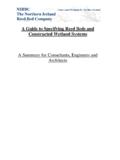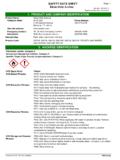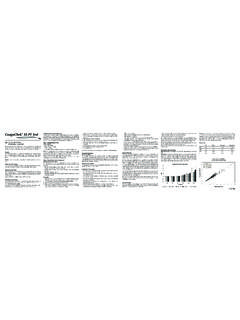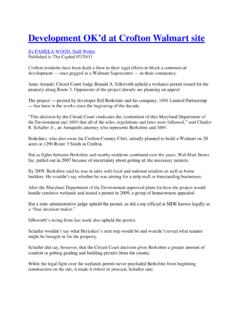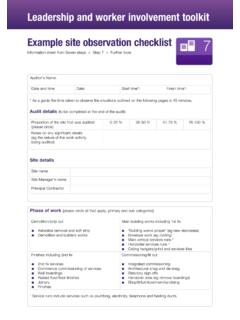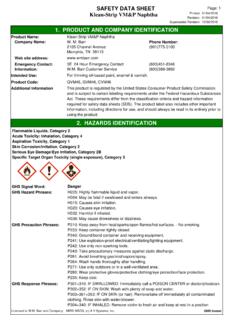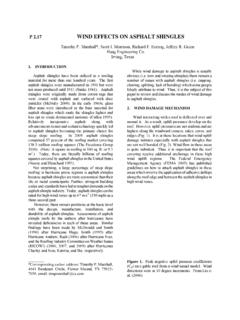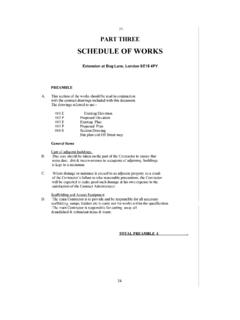Transcription of Slips Trips and Falls Protocol
1 Issue Draft Slips Trips and Falls Protocol Reference: CEF H&S Protocol 002. Page No: Page 1 of 8. PURPOSE. To provide advice and guidance to all persons involved in organizing, planning, managing work construction related activities to eliminate and reduce risk of injury from Slips , Trips and Falls . Both good and bad practice scenarios are documented to help clarify the expected best practice . approaches that should be undertaken to ensure the safety of all persons working in construction related industries. This document is not a definitive guide. Slips & Trips and Falls on the same level are the most common cause of major injuries at work. They occur in almost all workplaces, 95% of major Slips result in broken bones and they can also be the initial causes for a range of other accident types such as Falls from height.
2 The principles and practices stated in this document should be adopted, where reasonably practicable, by all CEF members. KEY MESSAGES ABOUT Slips AND Trips . Slips and Trips are serious Simple and minimal cost effective measures can reduce these accidents STATISTICALLY Slips Trips AND Falls AT WORK ON AVERAGE ACCOUNT FOR. In Northern Ireland, Slips trip and Falls was the cause of 25% of all accidents (HSENI Annual report). 33% of all reported major injuries 20% of over-3-day injuries to employees 2 fatalities per year 50% of all reported accidents to members of the public A 512 million per year cost to employers A 133 million per year cost to health service Incalculable human cost (Source HSE GB Construction Sector). MAIN CAUSES OF ACCIDENTS FROM A slip trip OR fall .
3 Walking over uneven ground, particularly when carrying large or unwieldy and awkward objects Tripping over building material not stacked correctly or waste materials carelessly disregarded Tripping over trailing cables Slipping caused by wet, gritty or icy surfaces Falling over due to soft and poor ground conditions Trips caused by small or sudden changes in level What the law says The Health and Safety at Work (NI) Order 1978 requires employers to ensure the health and safety of all employees and anyone who may be affected by their work. This includes taking steps to control slip and trip risks. Employees must not endanger themselves or others and must use any safety equipment provided. The Management of Health and Safety at Work Regulations (NI) 2000 build on Health and Safety At Work Order and include duties on employers to assess risks (including slip and trip risks) and where necessary take action to safeguard health and safety.
4 The Workplace (Health, Safety and Welfare) Regulations (NI) 1993 require floors to be suitable, in good condition and free from obstructions. People must be able to move around their workplace safely. Author :- Brendan Kelly page 1 of 8. Issue Draft Slips Trips and Falls Protocol Reference: CEF H&S Protocol 002. Page No: Page 2 of 8. ORGANISATION- EMPLOYERS AND EMPLOYEE DUTIES. EMPLOYERS. In line with HSG 155 (HSE Guidance in managing Slips , Trips and Falls ), Employers should develop a suitable system of managing the workplace to eliminate and reduce Slips , Trips and Falls . This management system should include, but not be limited to the following action;. Put in place a management system Plan: Deliveries to minimize the amount of materials on site and maintain safe access around site.
5 Proper arrangements for the removal of waste from the work area and its proper disposal in a safe and efficient location. A system of keeping work and storage areas tidy Designated walkways with good condition underfoot Level the ground if rutted Stone the ground if muddy Grit the access route if slippy Where small changes of level cannot be avoided, arrange sound temporary ramps or some other way of providing safe and easy access. Work with your employees to identify potential problem areas and set goals for improvement To avoid having trailing cables by using cordless tools. To place materials convenient to the area where they are to be used to reduce the need to carry objects over poor ground. Train: All employees the knowledge to identify and take action to remove or report potential risks Everyone on site knows to wear safety footwear that provide good grip.
6 All employees to immediately clean up spillages that could cause someone to slip . Cardboard should not be used to absorb spillages as this itself presents a tripping hazard. Organise: Make employees and subcontracted employee responsible for specific areas. Make sure corridors, stairways, footpaths and other areas used by pedestrian are kept clear of any obstructions. Keep inside and outside work areas adequately lit. Keep dismount areas such as the foot of ladders and access stairs clean and free from obstructions. Hang cables from temporary electricity supply on site at high level or use ground level cable Keep work areas tidy and use signs or barriers to warn people if obstructions can't be removed. Author :- Brendan Kelly page 2 of 8. Issue Draft Slips Trips and Falls Protocol Reference: CEF H&S Protocol 002.
7 Page No: Page 3 of 8. Control: Ensure working practices and processes are being carried out properly and keep where appropriate records of cleaning. Monitor and Inspect all access routes daily to ensure they are free from obstructions review: talk with (not at) your employees so they can buy in and provide feedback on measures are working. Carry out regular Look out for hazards like lighting, uneven floors and trailing cables. risk assessments Decide who might be harmed and how. Consider less abled people, visitors. Consider the risks, note any potential problems and do something about them. Record your findings. Regularly review the assessment. Author :- Brendan Kelly page 3 of 8. Issue Draft Slips Trips and Falls Protocol Reference: CEF H&S Protocol 002.
8 Page No: Page 4 of 8. EMPLOYEES. Take responsibility Here's a useful checklist to help improve safety for you and your colleagues in the workplace. No Requirement Yes No N/A. 1 Ensure you have adequate lighting available. Report any defects in any work equipment provided. 2 Make sure your work area is even and clean 3 Mark slopes and changes of levels 4 Safely store cables at ground level 5 Remove any obstructions to an area where they do not become tripping hazards 6 Clear up spillages immediately 7 Clear your workplace as you go 8 Wear suitable footwear at all times 9 Consider safety measures for visitors 10 Follow the correct working procedure put in place and use your initiative to make your workplace safer. 11 Plant operatives to report any defect to access steps into mobile equipment.
9 See a spillage? Instead of thinking it's someone else's problem, why not clear it up? Your actions could make the difference between someone getting injured or not. Author :- Brendan Kelly page 4 of 8. Issue Draft Slips Trips and Falls Protocol Reference: CEF H&S Protocol 002. Page No: Page 5 of 8. Slips Trips AND Falls - REAL LIFE SITUATIONS. (These real life situation can be used as tool box talks). 1 Following a night of heavy rain, a bricklayer, with thirty years experience set about laying block on a 250mm stepped concrete foundation. The rain water was pumped out of the foundation but left a slippy silty material on top of the concrete surface. Stepping down from the higher level, he lost his footing, fell backwards onto the concrete step and broke some bones in his back.
10 He never worked again. Weather conditions must be considered when planning access arrangements. 2 A visitor to site walked down a soil embankment to look at an area on the site where work was to be planned. He slipping and fell down the embankment and broke a bone is his ankle. He was off work for 12 weeks, requiring an operation to put a metal pin in his foot. The injured person sued the main contractor for personal injury compensation. Access arrangements to all areas of the site must be considered, with particular attention paid to visitors and members of the public. 3 An electrician was working of a stepladder inside a room of building which has suitable natural sunlight levels. He dismounted the stepladder and made his way through the room door into the hallway which was had temporary festoon lighting over half of the light bulbs where defective.
